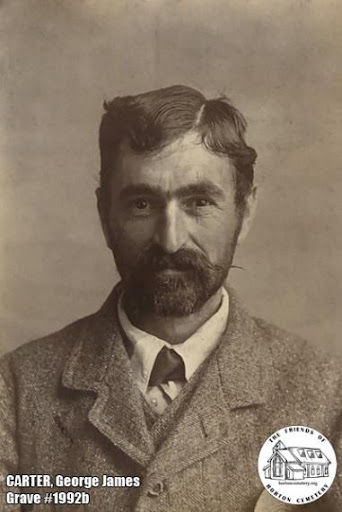b.1863-d.1916
James George’s parents
Although our subject’s name is given as George James Carter in his medical records, he was actually born James George Carter, the third child of seven born to George Carter and his wife Mary (née Gould).
The couple were married in the Church of St Thomas the Apostle in the City of London on the 2nd of March 1857. 28 year-old George, the son of William Carter, a clicker, was born in Clement Danes in Westminster.
In the marriage register he is described as a coachman. Mary was the 22 year-old daughter of farm labourer Thomas Gould and was born in the village of Ellisfield in Hampshire. At the time of their marriage the couple were living at 10, Symonds Inn, Chancery Lane in the City of London.
The first James George Carter
In the 4th quarter of 1859 in Kensington, Mary gave birth to her first child, a son called James George. However, this was not our subject who we know was born in 1863. The first James George does not appear in the family’s entry in the 1861 census but, according to GRO records, a James George Barry Carter died in Kensington in the 1st quarter of 1860 before reaching his first birthday. As there is no birth registered for a James George Barry Carter in that time period, we may assume that this was our subject’s older brother.
The 1860s and 1870s – James George’s siblings
In the 1st quarter of 1861 Mary gave birth to her second child, a daughter named Charlotte Sophia. In the 1861 census we find the family living at 8, South End, St Mary Abbott in Kensington. George is described as a domestic coachman.
A domestic coachman was usually employed by a gentry family who had their own stables or a mews where the coachman and his family would live above accommodation for carriages and horses. He would drive the family horse-drawn vehicles, including a covered carriage, a barouche or a dog-cart, taking the family on shorter holidays, visiting friends or to the station.
In the 3rd quarter of 1863 our subject was born in Kensington and named James George after his deceased older brother. Mary gave birth to two more sons before the end of the decade, George, born in the 1st quarter of 1865 and William, born in the 3rd quarter of 1869. Both boys were born in Kensington.
At the time of William’s baptism at the Holy Trinity Church in Brompton on the 7th of November 1869, the family was living at 24, Yeomans Row in Kensington. However, in the 1871 census we find them at 7, Hollywood Mews in Kensington. George senior is now described as a flyman, that is, a driver of a one-horse carriage hired by the day.
In the 1st quarter of 1873, Mary gave birth to her sixth child, a daughter named Emily. Her last child, a son named Edwin Thomas, was born in the 3rd quarter of 1875. The births of both children were registered in Kensington.
The 1880s and 1890s – a downturn in the family’s fortunes
By the time of the 1881 census the family had moved once again, this time to 71 Hargwyne Street in Lambeth. George senior was no longer a coachman but was working as a labourer. This downturn in the family’s fortunes is, perhaps, explained by James’s medical notes from 1900 which state that his father was an alcoholic. In the census we also learn that James, now aged 18, is working as a baker.
In the 1891 Census James’s family is living at 89, Dulwich Road in Lambeth. George senior is now a mission hall keeper, William is a ‘bootworker’, Emily is a dressmaker and Edwin is a shop boy. James, however, does not appear in this census. George senior died the following year in the 1st quarter of 1892 aged 64.
James George is admitted to Bexley Asylum
The next time we see James is on the 29th of August 1900 when, at the age of 36, he is admitted to Bexley Asylum from Lambeth Infirmary, following what his medical notes state was his first manifestation of insanity.
His doctor, George Robert Harcourt, described the behaviour which, to him, indicated that James was insane;
That he believes himself to be Christ’s brother, that he belongs to Christ’s band which is stationed at the Albert Hall, that Christ himself is there. That he has been speaking to him through signs and sounds that are going on in the ward now. That he is making tapping sounds in answer to his speeches.
6292-27-1 Colony Male Case Book
His comments were supported by the testimony of PC 220 L. James Bolland, who stated;
He [James] came to the constable and asked for a warrant to get £20 from Aldershot. Said that he was King of England and professor of the violin, said that he lived in the Albert Hall.
Facts communicated by others
James’s diagnosis is given as ‘epileptic insanity with emotional and hallucinatory exacerbations(?)’. Contributory and associated factors are listed as ‘neurotic heredity – asthma – father alcoholism’.
Interestingly, James’s occupation in these notes, dated 1900, is given as ‘musician’. There is no evidence that James made a living from music, but he was clearly a fairly accomplished musician as we discover in his later medical records.
His mother Mary’s address is given in the admission notes as 7, Birkbeck Road, West Dulwich. However, Mary is not living at this address in the 1901 census and, indeed, it has not been possible to find her in any records after the 1891 census.
In James’s 1903 medical record under ‘occupation’ we find ‘soldier (formerly a baker)’ and later, ‘baker until he became a soldier’. His residence is given as ‘Kensington, Ireland, India’ which would explain why he does not appear in the 1891 census. His notes explain that, prior to his admission to Bexley, “he had been away from home for 9 years. Part of the time was in Ireland and part in Bombay as an army servant”. However, up to now it has not been possible to find James in military records either as James George Carter or George James Carter.
James is admitted to Ewell Epileptic Colony
James remained in Bexley Asylum for three years until the 19th of August 1903 when he was transferred to Ewell Epileptic Colony, the third hospital to be built within the Epsom Cluster. James must have been one of the Colony’s first patients as it was not officially opened until 1904.
In the detailed case notes compiled on his admission to Ewell we learn that his general bodily health is ‘good’. As regards his mental state,
- His degree of consciousness is ‘complete’
- His attention to current events and when addressed is ‘good’
- His cognition of what is said to him is ‘good’
- His responses to questions on his personal identity (name, age, station in life), surroundings and time are all ‘correct’
- His volunteered conversation is ‘normal’ and ‘intelligible’, his flow of ideas is ‘normal’ and his reasoning powers are ‘good’
- His memory for current, present and remote events ‘appears good’
- He does ‘not now’ suffer from hallucinations, illusions or delusions
- He has no suicidal, homicidal, erotic or destructive impulses
- He is neither restless, noisy, dirty, mischievous or obsessive
- He is truthful, religious and sociable, with no evidence of criminality and his family affection is ‘good.
The only negative comment comes at the end of the report, “Has drunk heavily at times”. This is explained in the doctor’s first entry in his case notes: James “is the subject of epileptic insanity which seems to have followed a year’s excesses of alcohol. His first fit, he states, occurred when he was about 35 years old in India. He is habitually melancholic and is conscious that at intervals he becomes dazed and strange.
Typical fits are stated to be nocturnal… Occasionally has periods of disagreeableness in manner and conduct and at such times shows a disposition to seek clandestinely the company of female colonists. At other times his conduct is pleasant.”
A gradual decline
We do not have access to James’s complete case history. However, the entries available to us give an insight into James’s mental and physical state while in the Colony. Although there are a number of positive comments, the overall picture does appear to be one of a gradual decline in James’s mental and physical health. Here is a selection of the comments made by his doctors:
- Is making himself useful tailoring and also in the band
- Had a fit on August 30th, September 24th, 27th, 29th and 30th, October 1st, 19th and 22nd, November 17th and 29th, December 10th and 22nd and January 2nd…
- He has had one attack of excitement and was off work for 3 days. He frequently shouted out Fire! Fire! and when asked why said he was facing the guns
- Has fits…and at irregular intervals has confusional attacks when he feels ‘light-headed’
- On some of these occasions he is excited and does acts of which he has no subsequent memory
- He works well as a tailor and is a useful member of the band as a violinist
- Became very excited and said that a current of electricity was pulling out his teeth
- Except for the attack mentioned…he has become very well. He is pleasant, agreeable and never grumbles
- (James) is one of the aristocrats of the colony. He has had no phase of incompatibility in the last 3 months
- He was missed from the dining room shortly after 12.30pm; subsequently found walking in the Kingston Road by one of the staff…It was then evident that one of his confusional states was coming. He remains partly dazed and does not realise fully what he did
- It is noticed…that when one of these confusional states are (sic) approaching, colonist (James) will sit down and play the piano all day
- Had a very severe fit in church last Sunday
- He has had a period of great mental confusion and depression from which he is slowly recovering but which seems to have left him more demented
- Has a superficial burn on the left palm, the result of falling in a fit against stove in villa – treated with Vaseline
- Is subject to recurrent excitement, usually quiet, reserved and appears somewhat depressed
- He has instability of temper by becoming quite excited(?) over trifles and when so stamps his foot
- Struck colonial servant in mouth without provocation
- Recently his behaviour has undergone a change for the worse…About a month ago he got on a railway line and had to be brought back. There was a struggle to get him back. He has become slovenly at his work
- Face pale, cardiac rhythm a little irregular. He does not sleep very well
- Sulky and capricious and at times appears decidedly depressed in manner. Refuses to take medicine
- He is sullen, morose and taciturn and is prone to explosive outbursts during which he suddenly strikes out at anyone near him
- He is civil and well-behaved though not very sociable. He does his work well
- He has had 8 seizures in the quarter, all being of major type
Sadly, James’s health deteriorated and he died in the Colony in January 1916 aged 52. He was buried in Horton Cemetery on the 7th of January 1916 in plot number 1992b.




